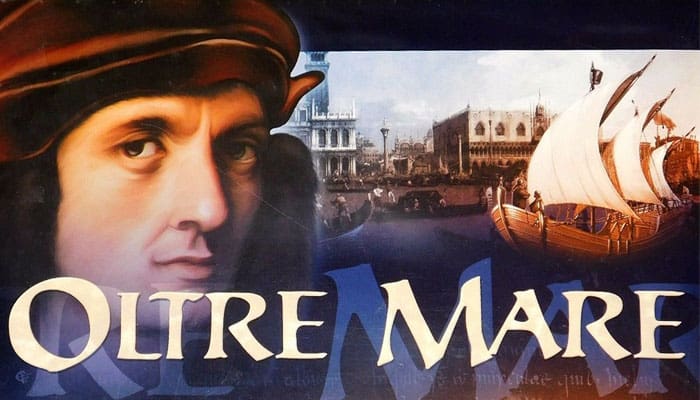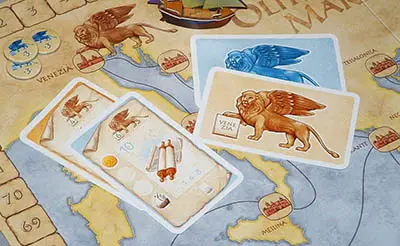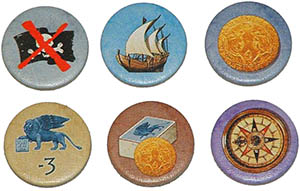
Components

- 98 Goods Cards (in 7 colors)
- 1 Venice Card
- 5 Summary Cards
- 5 Merchant Cards (in 5 colors)
- 10 Wooden cubes (in 5 colors)
- 1 Board
- 32 Harbor markers
Areas of the Game
Goods Deck
The players draw Goods Cards from this deck.
On the board:
Map
The map shows the Mediterranean sea and the Harbors. One wooden cube for each player represents the player's Ship. Every Ship moves along courses (dotted lines) and stops at Harbors.

Ducati Points (score) Track
This is a wooden cube for each player on this Track indicates the number of Ducati (the currency of Venice) Points a player owns.

Beside the player:
Player's Hand
This represents the player market (Goods player can play).
Cargo Stack
This is a stack of faced up Cards. These Cards represent Goods already loaded on the cargo. It is forbidden to look at the Cards on this stack. Anyway the top Card must be visible to everyone. This Card shows:
the Maritime Power icons, equal to the maximun number of Cards that the player can hold in his hand at the begin of his next turn (see Maritime Power Phase)
the Load icons, equal to the number of Cards to be played during the next player's turn (see Main Phase)
Pirate Stack
This is a stack of faced down Cards. These Cards represent the Goods stolen by the Pirates (see Pirate Action). The player can buy Cards from his own Pirate Stack (during the Trade Phase). At the end of the game subtract 1 Ducati Point to the final score for each Card still on the Pirate Stack.
Merchant Card
This iindicates the color and the name of Venetian Merchant's family of the player. The Summary Card and the Merchant Card indicate the number of the player's Prestige Points.

Setup
Join the 4 parts of the board and put it on the center of the table. Shuffle the Harbor markers and place them face up, randomly, on the Map. One marker on each Harbor. Markers not used are removed.
In a 2 player game remove all the Corn Cards. Shuffle all the Goods Cards in order to form the Goods Deck. Choose who is the first active player (for instance who lives closer to Venice).
Draw cards from the Goods Deck until you find a Card with the name of a Harbor. Give this Card to the first player: this will be his first Card on his Cargo Stack. Do the same drawing until all players have one Cargo Stack.
Each player chooses a color and takes the Merchant Card and the two wooden cubes of that color.
Each player puts one wooden cube on the "11" square on the Ducati Points Track and the other wooden cube on the Harbor indicated by the Card on his own Cargo Stack. Discard markers on these Harbors.
Each player takes one Summary Card and puts it onto the Merchant Card in order to indicate the number of Prestige Points as "0".
Reshuffle again all the Goods Cards and insert the Venice Card at about the middle of the Goods Deck. Each player draws 4 Cards from the Goods Deck to form his hand.
Object of the Game

The game is over when the last Card of the Goods Deck is drawn. The active player who draws the last card must end the turn.
Then there is the final score (see End of the game and Final Score) and the winner is who has the highest number of Ducati Points.
Game Play
During his turn the active player performs the following Phases (in this order).
Maritime Power Phase

At the beginning of the turn the active player checks his Maritime Power, which is shown as the number of Venetian Lion icons on the Goods card currently on top of his Cargo Stack. The player must then discard his hand down to the size of his current Maritime Power. He can choose which Cards to discard. These are discarded face down on his Pirate Stack.
Example. At the begin of his turn Stefan has 5 Maritime Power icons on the Cargo. He has 7 Cards on his hand: he must discard 2 Cards he chooses, put these on his Pirate Stack.
Trade Phase

The active player can freely trade Cards and/or Ducati Points with the other players. Other players can trade only with the active player.
During a negotiation, players can ask about Goods and icons on the Cards they intend to trade: players must tell the truth about the Goods, but they can cheat about all the other icons on the Cards.
Players who trade with the active player gain 1 Prestige Point (move the Summuary Card down one number on the Merchant Card). During the same turn only 1 Prestige Point can be gained by each player, no matter the number of trades are done. The active player gains no Prestige Points for trading.
The active player can choose to buy Cards from the Goods Deck or from his Pirate Stack. Each Card costs 3 Ducati Points (no matter if he buys from the Goods Deck or the Pirate Stack). Cards costs 4 Ducati if the active player has 0 Ducati or less. On the Ducati Track the cube goes under the zero to indicate negative points.
The active player may alternate the trade with other players and the buying of Cards. He can trade how many times he wants with the other players, but can buy no more than 4 Cards from the Goods Deck or the Pirate Stack. However he can buy one by one.
Main Phase

The active player must play Cards from his hand and place them face up on the table. The number of Cards he has to play is indicated by the number of the Load icons on the Goods Card on the top of his Cargo Stack.
If the player has not enough Cards in his hand he cannot start the Main Phase: he must first buy or trade Cards during the Trade Phase.
Each Card shows 2 of the 4 possible Actions: Ducati, Pirate, Market, Sailing. These Actions must be performed in the following order:
-
Ducati Action.

The active player gains Ducati. If the total number of Ducati icons on the cards played is 1, the player gains 1 Ducati Point. If the number of Ducati icons on the cards played is 2, the player gains 3 Ducati.
If the number of Ducati icons is 3 or more the player gains 6 Ducati.
-
Pirate Action.

The active player must move Cards from the Goods Deck and put them on his Pirate Stack. The moved cards are put face down without looking at them.
If the total number of Pirate icons on the cards played is 1, the player must move 1 Card from the Goods Deck to the Pirate Stack. If the number of Pirate icons on the cards played is 2, the player moves 3 Cards to the Pirate Stack. If the number of Pirate icons is 3 or more the player moves 6 Cards.
-
Market Action

The player must draw Cards from the Goods Deck and put them on his hand.
If the total number of Market icons on the cards played is 1, the player must draw 1 Card to add to his hand. If the number of Market icons on the cards played is 2, the player draws 3 Cards.
If the number of Market icons is 3 or more the player draws 6 Cards.
-
Sailing Action

The player must move his own Ship along the shipping lanes on the map the exact number of spaces (Harbors) equal to the number of Ship icons on the Cards played. It is not allowed to travel twice on the same route on the same turn.

If there is a Harbor marker where the Ship stops, the player takes this marker: this will be his new active Harbor marker for that player (see Harbor Markers). If there are no markers, the active player lose his active Harbor marker (flip it).

Cargo Phase
After the active player has performed all the Actions, he load the played Cards on the Cargo Stack. Cards are stacked face up and the order is choosen by the active player. This order is very important for the final score (see End of the game and final score).
The Card on the top of the stack (the last Card loaded) is also important for the next player turn: the number of Maritime Power icons defines the maximun number of Cards in hand at the begin of the next player's turn; the number of Load icons defines the number of Cards that will be played on the next player turn.
At the end of his turn the active player can keep all his Cards in his hand, even if the number is greater than the number of Maritime Power (exceeding Cards must be discarded only at the begin of his next turn).
New Active Player
The player at left of the active player becomes the new active player.
Venice Card & Prestige Points

When the Venice Card is drawn on the Goods Deck extra Ducati are gained.
The player with the most Prestige Points gains 6 Ducati, the second player gains 3 Ducati, the third player gains 1 Ducati Point. The other players gain no points. If there is a tie the same number of Ducati is gained.
All players must set the number of Prestige score back to "0" as at the beginning of the game.
The Venice Card is removed and the active player continues his turn.

End of the Game
When the Goods Deck is depleted the game is over. The active player can finish the turn (he draws no Cards from the Goods Deck if he should).
Players gain Ducati Points as described.
-
Score for Selling Loaded Goods

Each player "sells" the Goods Cards from his own Cargo Stack. The score depends on the number of Cards of the same Good grouped on the Cargo Stack. For this reason it is important that the order of the Cards on the Cargo Stack is not altered.
Each player starts from the Card on the top and continues drawing Cards from his Cargo Stack until Goods of the same kind are grouped together. A Card with a different kind of Good begins a new set.
Cards of the same Good that are not grouped together in the stack are considered to be part of different sets.
Each group of Cards is considered. There is a particular sequence of points for each Good (see the Table on the right or each Card). The numbers on the sequence indicates the number of Ducati Points gained if the group is formed by that number of Cards.
If a set is formed by a number of Cards greater than the number on the sequence, player gains the last number of the sequence.
-
Score for Harbor Markers
The player with the most Harbor markers scores 6 Ducati points. The second player scores 3 Ducati. The third one scores 1 Ducati. The other players score nothing.
If there is a tie among two or more players the player with the most number of Port markers of different kind wins the tie. If there is still a tie, all these players score the same number of Ducati.

-
Score for Prestige Points
The player with the most Prestige Points scores 6 Ducati Points. The second player scores 3 Ducati Points. The third one scores 1 Ducati. The other players score nothing. If there is a tie all these players gain the same number of Ducati Points.
-
Negative Score From Pirate Stack
Each player lose 1 Ducati point for each Card in his Pirate Stack.
The winner is the player with the highest number of Ducati.
Continue Reading
